Baby Birds in My Backyard
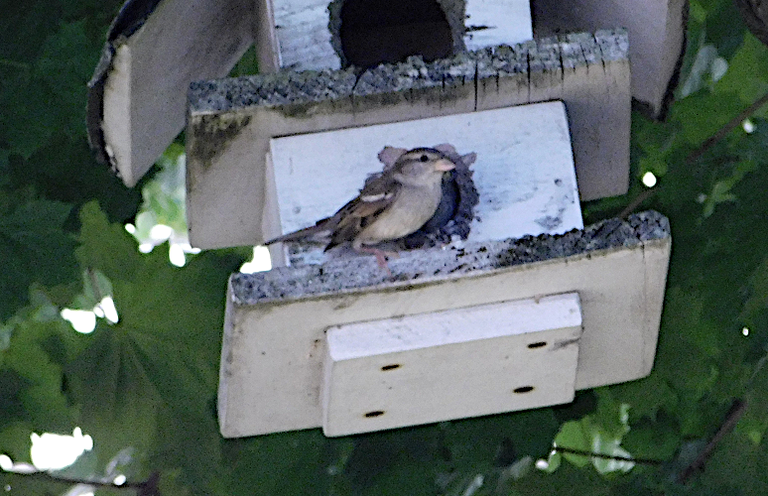
In spring of this year we played host to a family of birds in our backyard. The very short YouTube video below was shot from my phone after I suspected the birds were in the birdhouse. I could barely see them, but did glimpse of some activity.
I love birds but don't know a lot about them. I tried to identify the birds in my backyard by looking at pictures on the Internet, and by reading descriptions of behavior. I'm guessing the birds in my birdhouse are house sparrows (Passer domesticus). Here is a picture from Wikimedia Commons of a typical house sparrow.
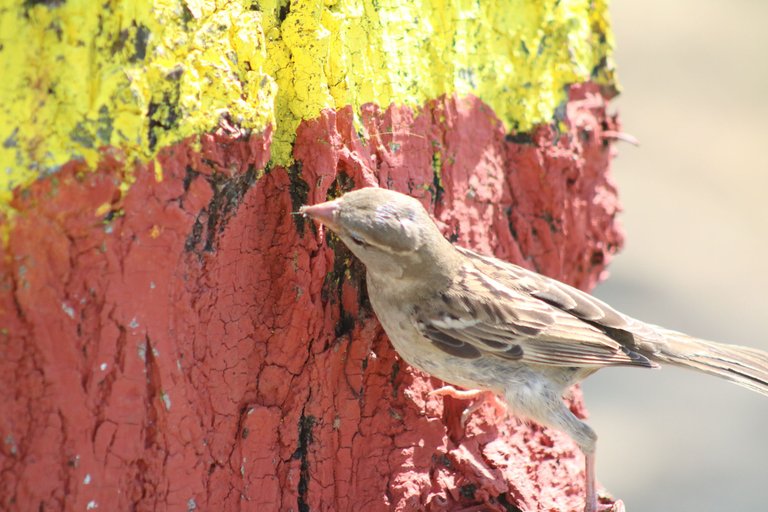
Nabin K. Sapkota. Used under CC 4.0 license
A few weeks after my sighting of the birds my daughter called me to the backyard. The residents of the birdhouse were clearly evident. They had grown, and there seemed to be two babies. Their chirping was quite loud. I could see their yawning beaks in the doorway of the birdhouse. Dinner must have been overdue, because these chicks were making a racket. 'Begging' is a survival tool for baby chicks...the yammering prompts a parent to bring food.
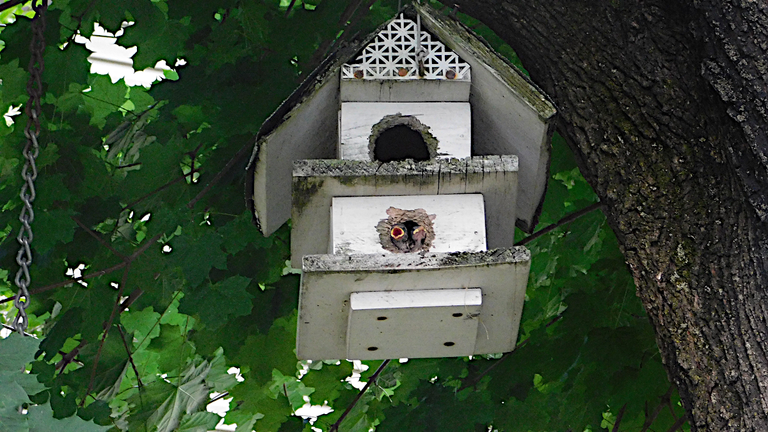
One of the chicks was larger than the other. The larger one seemed to be more assertive. You can see the smaller one in the picture below barely has its mouth open and seems to be in the shadow of the larger chick.
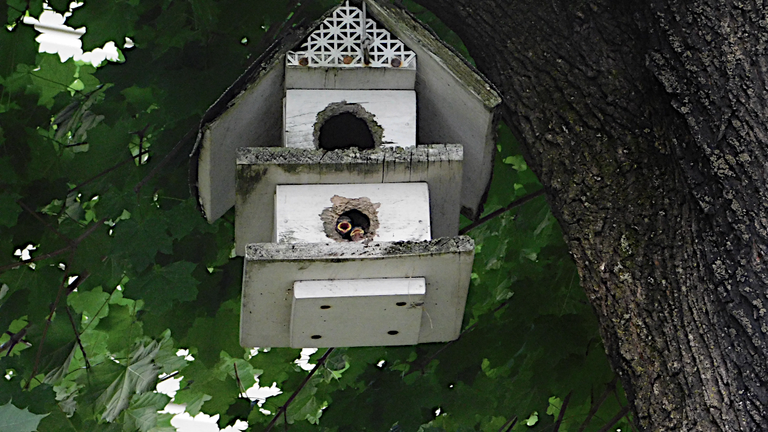
Here is another shot of the siblings yelling for food.
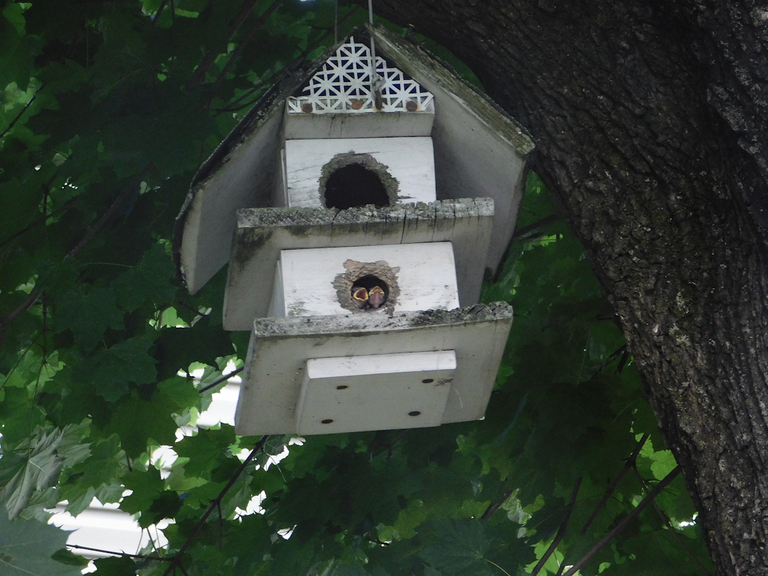
I'm not sure if this next shot shows the mother/father with the small chick or if the much larger chick is dominating the picture. I do believe though that the size of the head indicates that the bird on the left must be a parent.
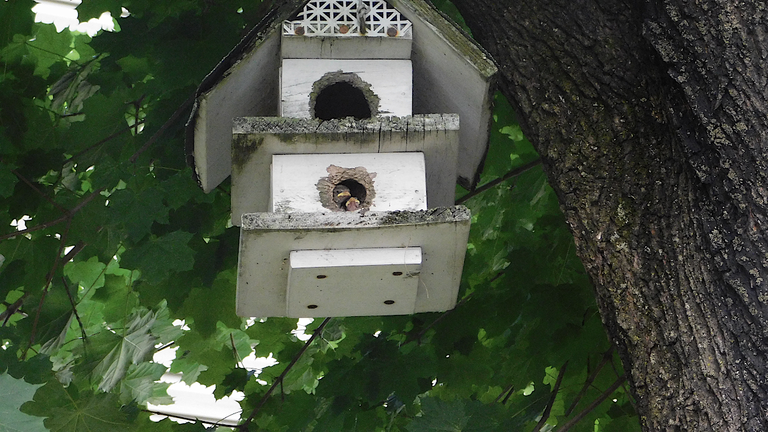
At some point I didn't see the smaller chick anymore. Only one chick appeared in the door and this is the large chick. I was pretty sure at this point that the smaller one had died.
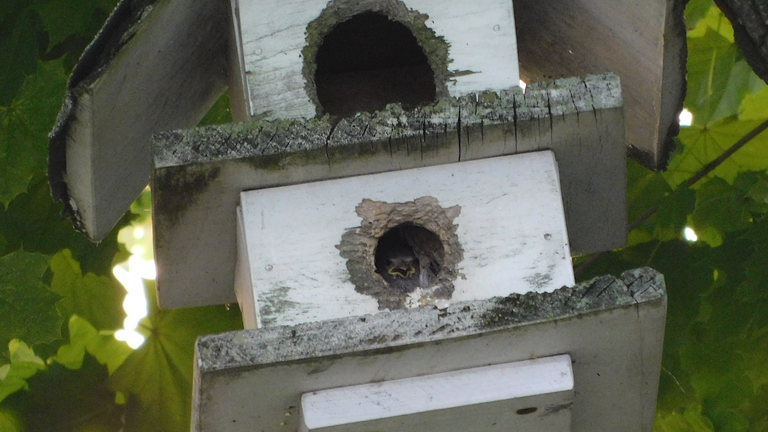
Although there are some bird species where siblings kill each other (siblicide) and where even parents kill the weaker of the brood, that does not seem to be the case with house sparrows. House sparrows do kill other birds, especially bluebirds, but this is mostly for nest or territory competition. They are not dedicated bluebird predators.
Generally, most sources I consulted say that house sparrows do not cannibalize each other. I did find one paper that describes what seems to be a parent feeding a chick the remains of a deceased nest mate. This feeding is presented however as a rare instance.
I was lucky to catch a shot of the mother/father as this parent was delivering food to the now-solitary chick.
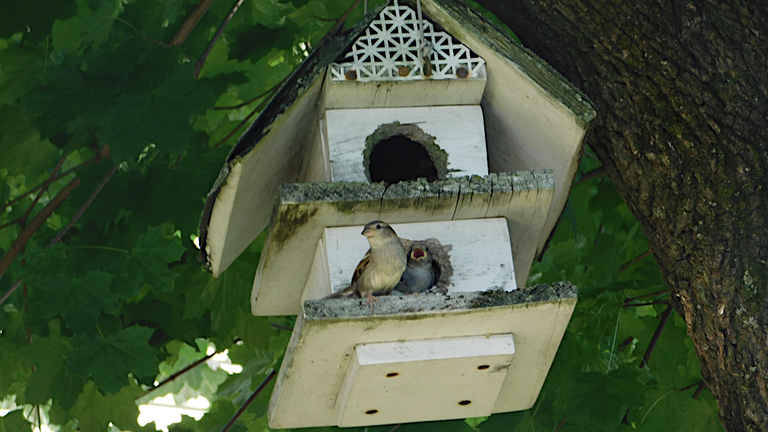
House sparrows are found in many parts of the globe. According to Wikipedia they are the most widely distributed wild bird in the world. House sparrows are strongly associated with human habitation. They tend to nest where people live.
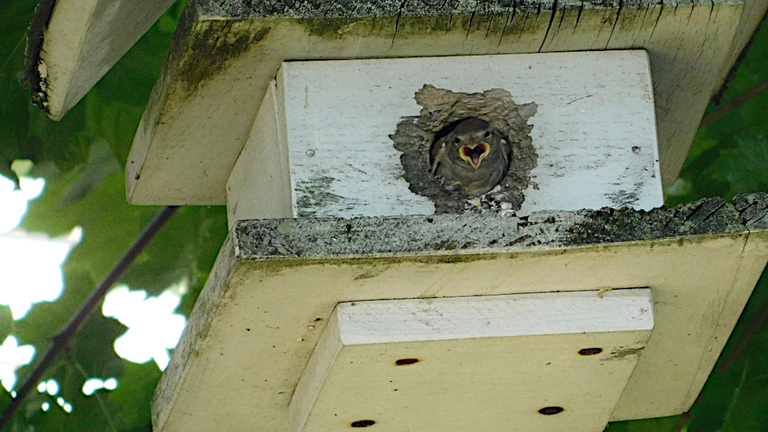
When the picture above this paragraph was taken, the bird family in my backyard likely was reduced to just one chick. As you can see, this chick has grown to be quite large and occupies the entire entrance to the birdhouse. I had the feeling the bird was looking straight at me when I took this picture.
According to the website All About Birds, the house sparrow may be found across the U. S. and Mexico. The bird does not migrate, and may also be found in parts of South America--especially in Brazil and along the west coast of the continent.
The house sparrow is believed to have originated in Eurasia, Africa and the Middle East. In 1851, house sparrows were deliberately introduced to the U.S., when several pairs were released in Brooklyn, NY. Today the bird is so abundant that some people consider it to be a pest. The house sparrow aggressively defends its territory and even poaches on the territory of native bird species. The bird has been noted attacking 70 different bird species.
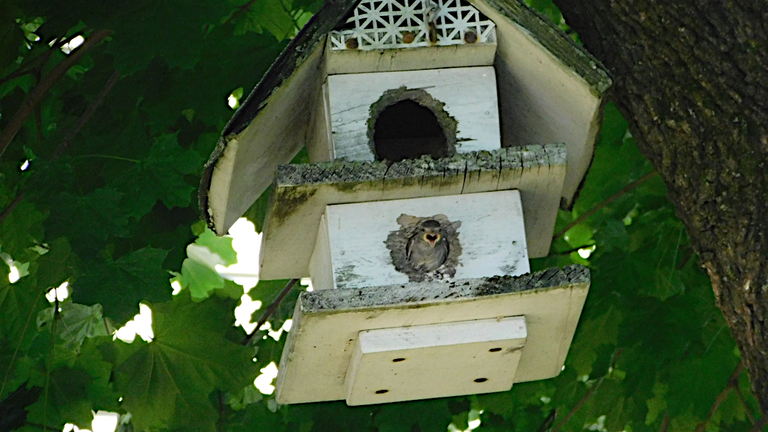
In the picture above, the chick in my birdhouse is halfway through the door. This position, perched in the doorway, does not seem to be safe. Sure enough, a few days later my daughter found the little bird on the ground. She wasn't sure if the chick had fallen or if it had attempted to fly.
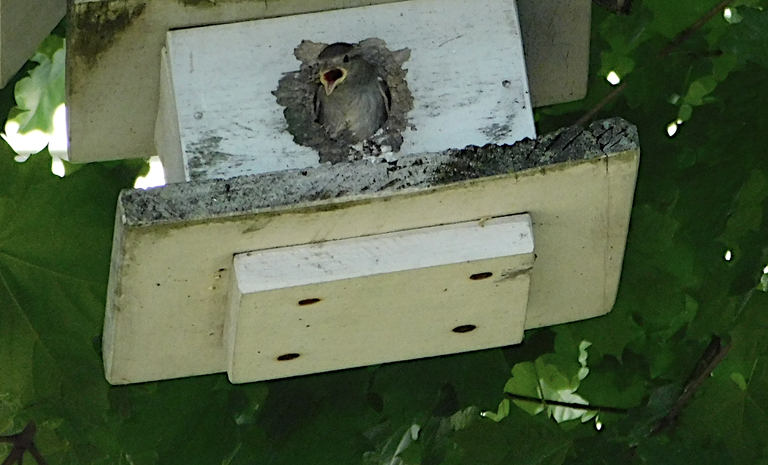
In the picture above, the bird is almost out of the nest. This is a side view of the bird, taken on the same day as the previous picture.
House sparrows may have as many as four broods a year and may lay as many as eight eggs. However, they may also have only one brood and lay one egg. I'm not sure how many eggs my little backyard brood began with, but it seems obvious that only one chick survived.
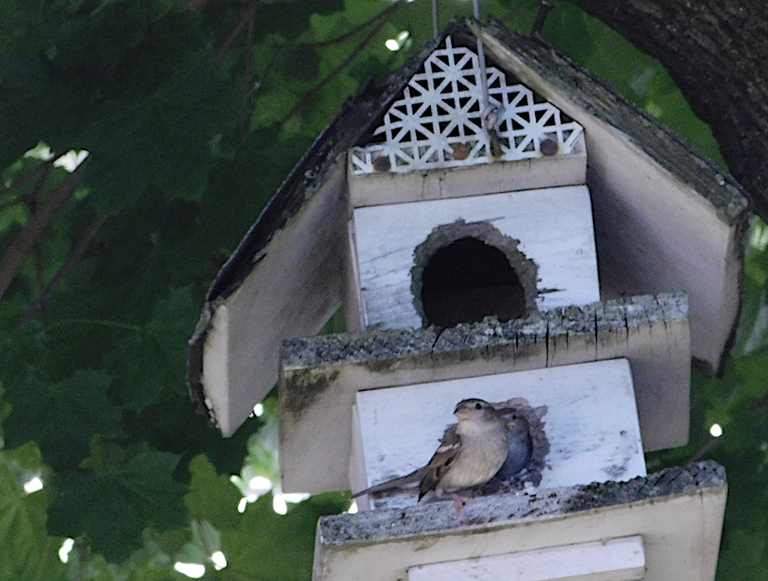
In the picture above, there is one parent and the rather large chick behind. The young bird looks well developed.
Here is the chick looking out to the right, the direction from which its parent flies for a feeding. If you look at the video that heads this blog, you'll see that the tree is to the left of the birdhouse and the wide world, from which food will come, is to the right.
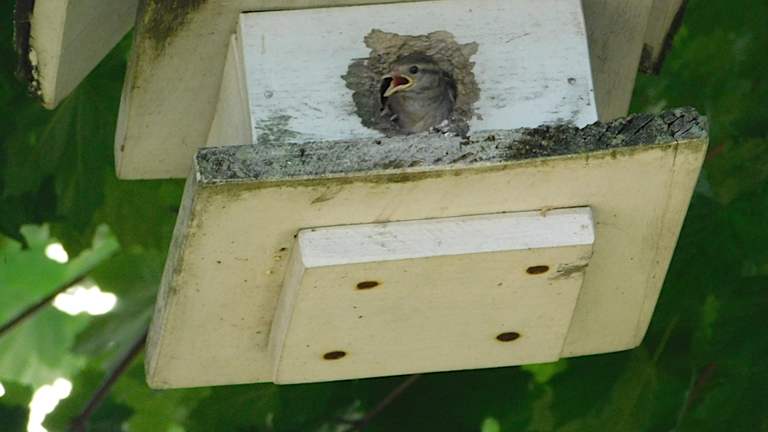
Both father and mother incubate eggs and feed the chicks once they are born. Although the father may feed the mother while she is watching the nest, the mother also will leave to eliminate and to find food.
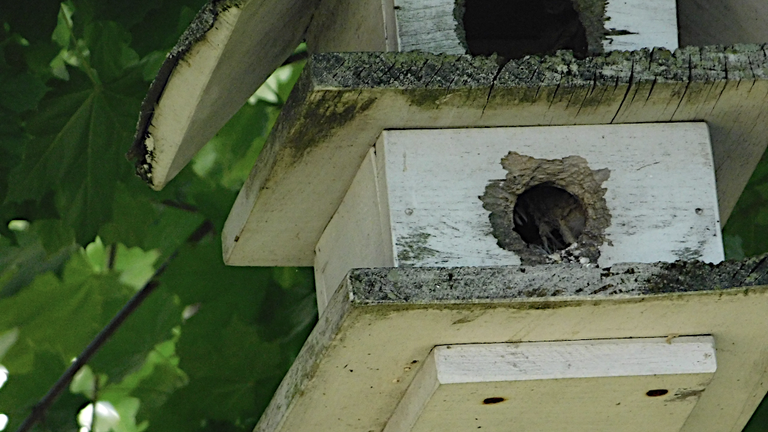
The picture above was taken when the chicks were very young. It seems in this shot that the beak of one chick is on the left, and the back of a second chick is on the right. It's hard of course to see exactly what is going on in the nest.
When my daughter saw the chick on the ground she wasn't sure what to do. The bird's mother/father was nearby, chirping at its offspring. My daughter looked up information on what to do and when she returned the chick was gone, although she could still hear chirping.
Did that chick survive? Did it fly away? Was it coaxed by its mother to safety. Did one of the neighborhood cats find it?
We wish our little chick well. I hope this bird family decides to revisit our backyard birdhouse this summer. It would be nice to see another family and root for that family's success.
Thank you for reading my blog. Health and peace to all.
All photos in the blog are mine, except for the one credited to Wikimedia Commons.
oh kudoes for hosting a bird house, definitely those times we need to help other creatures who are struggling to find space within us
it looks slight different than a passer, might be same family tough. that chicks are su cute
if they are on the ground it's better not to touch them, parents might abandon them if you do
They are so cute! My daughter didn't feel comfortable touching it. It's parent was sitting on the fence, chirping loudly.
She (my daughter) saw a bird sitting on the birdhouse yesterday. Maybe we'll have another family.
Thanks for reading and commenting.
Great photos! We had a similar spectacle just outside our kitchen window, where a family of sparrows (I think) had made a home in the drainpipe of our shed. When fledging time arrived, one little one tumbled to the ground. We weren’t sure whether to intervene, but like your daughter, we decided to let nature take its course. Sure enough, after much encouragement from mum (or dad), stationed on the shed roof , the little one finally took flight.
That makes me happy! Sounds exactly like what the parent was doing with this little fledgling.
The chick grew so fast. I wasn't prepared to see it leave the nest that soon.
I hope another one nests in the house. It's great fun watching them and listening to them.
Congratulations @agmoore! You have completed the following achievement on the Hive blockchain And have been rewarded with New badge(s)
Your next target is to reach 18000 replies.
You can view your badges on your board and compare yourself to others in the Ranking
If you no longer want to receive notifications, reply to this comment with the word
STOPThis is such a lovely story! The baby birds with their begging wide-open beaks look sooo cute! 😍
Thank you. It was a pleasure to share the backyard with them for a little while. We have a dog, but the birds seem to know he can't climb a tree :)
!discovery 30
Thank you, @phage93!
This post was shared and voted inside the discord by the curators team of discovery-it
Join our Community and follow our Curation Trail
Discovery-it is also a Witness, vote for us here
Delegate to us for passive income. Check our 80% fee-back Program
Thank you, @discovery-it!
Birds are so uplifting, inspiring, and just bring cheerfulness into one's life. Those nesting moments, however, can be traumatic. Their sibling rivalries appear more intense than those of us humans. Then again, we're not holed up in a tree competing for resources, so there's something to be said about living in houses. 😄 This a wonderful article on these house sparrows, and I hope they revisit your home for more nesting action.
If you look at the difference in size of those two siblings, it's obvious one of them may be in trouble. I wonder if the chick hatched later, or if it was just born small and the larger chick gobbled resources?
Kind of sad. But that's life.
I do think they are coming back, and I hope the little took flight.
I have to say that learning about the nesting habits of the sneaky cuckoo bird opened my eyes about the truth concerning adorable creatures like chirping birds. 😄 I hope the ones in your birdhouse behave and get along.
I can't imagine how the animals get used to it.
After breeding dogs for seven years I always do try and feel the pain when the runt of the litter croaks.
It pains my heart😔
This was fulfilling to watch though 😂😂
Birdwatching from your own backyard 😂😂
To me, that little bird looked like a columbina (Picui dove). But it was ungrateful; after you gave it shelter in your yard, it flew away.
Hi Agmoore! You haven't written for days. How's your husband doing? I hope he's well now. May God bless you and give you good health, along with your family. Have a happy one.
Hello @rammargarita
It looks like the adult bird has returned. I think we will have another family!
I am very busy here, because of my husband. He is doing better, thank you for asking. This is a long process--as you know--and I find it's hard to focus on a blog. I love Hive and I love blogging, so I will find time.
I hope you are well and are enjoying time with your family. God bless all of you.